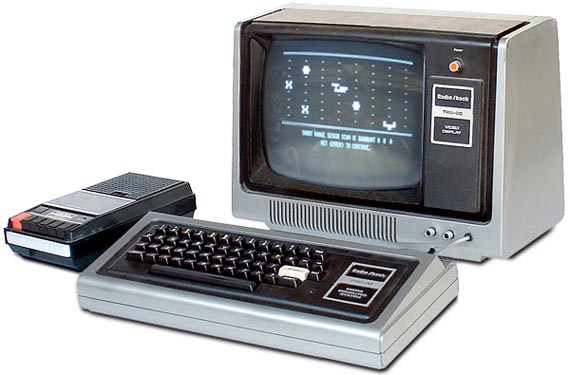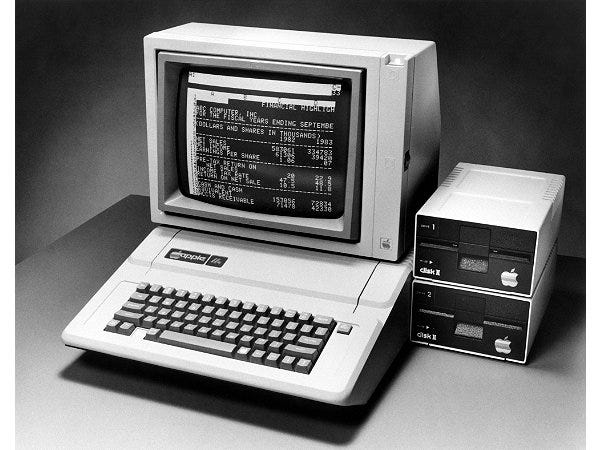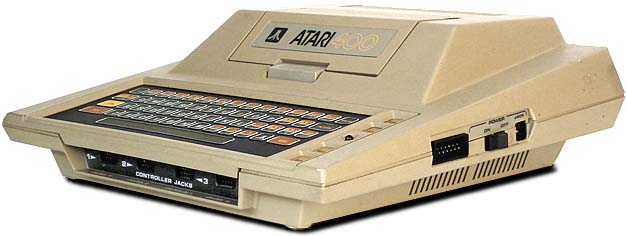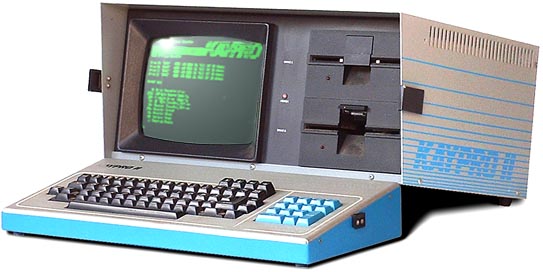![]()
 It was forty years ago this fall, in 1977, that I bought my first computer. I had little experience with computers prior to that – a few weeks working after hours on an APL system at the U of T, mostly to play games against the machine, reading a few magazine articles on the coming ‘personal’ computer wave. Nothing seriously hands-on, experience-wise, and no programming skills either. But as soon as I saw one, I had to have it. And so I bought one.
It was forty years ago this fall, in 1977, that I bought my first computer. I had little experience with computers prior to that – a few weeks working after hours on an APL system at the U of T, mostly to play games against the machine, reading a few magazine articles on the coming ‘personal’ computer wave. Nothing seriously hands-on, experience-wise, and no programming skills either. But as soon as I saw one, I had to have it. And so I bought one.
Since then, I have not been a day without one, and generally had more than just one in my home. As many as six or seven at one time, back in the early 1980s, all different brands. But that was when I was writing about them, editing computer books and writing computer manuals.
My first computer was a TRS 80, Model 1. TRS stood for Tandy Radio Shack. It was a 16KB computer (yes: that’s 16,384 bytes of memory) In comparison, my current laptop has 8GB, or 8,388,608 kilobytes: 512 times the Model 1’s amount of RAM!
It was powered by a Zilog Z-80 eight-bit processor. My current machines all run 64-bit, multi-core processors. It had no USB ports, didn’t use a mouse, and had no audio card. Smartphones today are more versatile and more powerful. But not as much fun.
Before I bought it, I debated for a week or two whether to get the TRS or the competing Commodore PET, powered by the 6502 processor. It had similar limitations in memory and input devices, but came with a green and black screen integrated with the keyboard in one unit. But the TRS was sold at a nearby Radio Shack store within walking distance, and they also offered nighttime classes to teach the basics. The PET was only sold at stores downtown, so I bought the closer one.
I had to boot it and load programs from a cassette tape player. A year or so later, I upgraded to a 64KB RAM system and dual floppy (5.25″) drives. Each floppy could hold about 160KB of programs or data. It had a standalone B & W monitor that didn’t have any graphic capability, although canny programmers used the blocks in the ASCII character set to create pseudo-graphics (a bit like today’s Dwarf Fortress game displays, but only in B&W).
I learned to write programs in BASIC on that machine (and subsequently improved on the Atari computers). In those days, you could buy tapes of programs in BASIC, or type them in – rather laboriously – from listings in magazines and then alter them. I learned some assembly code, too, although I never programmed anything more than a subroutine or two using it.
The original TRS-80 only offered uppercase characters, so to get lowercase, I had to open the case, and piggyback some new chips, soldered onto the motherboard (a technique I learned from a contemporary electronics magazine; I was a bit of a solder jockey back then). That modification was made because what I saw the computer for was a storytelling machine. I wanted to write books on it. And for that, I needed lowercase.
I learned the structure of DOS commands, too, from that machine – which made the later move to R/CPM and then Microsoft DOS fairly painless when I changed systems. While a lot of non-techie people struggled with DOS, I actually enjoyed working with it (and still use many commands in Windows CMD today…). I’m also still prone to get out a screwdriver and open up pretty much every device I’ve ever owned, although I haven’t soldered much in a few years.
A couple of years later, I would also own a PET. In the next several years, I would end up with a Commodore 64, VIC 20, Atari 400, Atari 800, Apple II, Kaypro II, TI (Texas Instruments) 99, Sinclair, Atari St, Apple Lisa, Apple Macintosh, TRS-80 Model III, Osborne, IBM PC, Compaq, Dell, and a few others. I pretty much bought new computers as soon as they were available. I had more fun with computers back then than I’ve ever had since.
 The market was changing and growing rapidly as new companies came into the field. I gravitated to the 6502-powered Atari in the early 1980s as the most advanced (and coolest) system around. It had colour display, had dedicated graphics and sound chips, slots for expansion, a cartridge slot for programs and games, and external ports for devices. I spent a lot of time exploring it and reading every technical manual and article I could find. I started compiling the information in a binder for my own use, and then learning about the functions by experimenting and writing small programs to explore the effects. I stayed up well into the early morning hours on many occasions, obsessed with learning how the machine worked.
The market was changing and growing rapidly as new companies came into the field. I gravitated to the 6502-powered Atari in the early 1980s as the most advanced (and coolest) system around. It had colour display, had dedicated graphics and sound chips, slots for expansion, a cartridge slot for programs and games, and external ports for devices. I spent a lot of time exploring it and reading every technical manual and article I could find. I started compiling the information in a binder for my own use, and then learning about the functions by experimenting and writing small programs to explore the effects. I stayed up well into the early morning hours on many occasions, obsessed with learning how the machine worked.
That led me to write a 350-page book about the memory system for programmers (Mapping the Atari, Compute Books, 1983, revised 1985 when I regained the copyright). Eventually, that book sold more than 60,000 copies and its royalties helped me buy my first house, in 1985. And, yes, it was written on the Atari 800 (I still have the disks and the original printout).
A brief digression…
 I recall one day sometime between late 1979 and summer, 1980. I was in a Toronto computer/electronics shop on Queen Street West. There were several of us standing around, chatting about hardware, software and modifications – all of us, including the salesman (in his late 20s) looking decidedly geeky (aka scruffy) in our casual wear. This was the sort of store in which you could buy capacitors and transistors from bins and everyone carried a little pocket decoder for the colour coding on resistors. Many software programs were sold on cassette tapes in plastic baggies with photocopied instructions, hanging from pegs on the wall. There were separate bags for PET programs, TRS-80 programs and Apple programs.
I recall one day sometime between late 1979 and summer, 1980. I was in a Toronto computer/electronics shop on Queen Street West. There were several of us standing around, chatting about hardware, software and modifications – all of us, including the salesman (in his late 20s) looking decidedly geeky (aka scruffy) in our casual wear. This was the sort of store in which you could buy capacitors and transistors from bins and everyone carried a little pocket decoder for the colour coding on resistors. Many software programs were sold on cassette tapes in plastic baggies with photocopied instructions, hanging from pegs on the wall. There were separate bags for PET programs, TRS-80 programs and Apple programs.
Suddenly the door burst open and in strode a Businessman in an immaculate pin-striped suit, with briefcase in hand, looking like Roger, straight out of Mad Men. Determined look on his face. He brushed past us and stood upright at the counter, looking at the salesman with a stern, commanding gaze and announced. “I want to buy a Visicalc.”
Visicalc was the first spreadsheet program, available at that time only on the Apple II. The sales guy nodded and took down a small box from a wall display nearby. “Here,” he said, quoting a price (somewhere around $100, I believe).
“What’s this?” the Businessman demanded, eyeing the box with suspicion.
“That’s Visicalc,” the guy behind the counter said and repeated the price.
“This isn’t what I asked for!” the Businessman retorted. “I want a Visicalc.”
The salesman tried to explain that, yes, Visicalc was in the box.
“No it isn’t,” the Businessman replied. “I just came from a demonstration of it in my office. It was remarkable. It’s going to change the way we do business. This is the future! And I want a Visicalc now. All of it, not just this little box.”
The somewhat bewildered sales guy looked at us, but we were just standing in silence, watching this unfold. The salesman tried again. “Honest, this is all of it.”
“No it isn’t,” the Businessman replied. “I saw it just an hour ago. Where’s the screen? And the, what-do-you-call-it? The keyboard! Where are they?”
“Visicalc is a program,” the clerk responded. “It doesn’t come with all that. They’re part of the computer. It runs on an Apple computer. You need to have one of them to make it work.”
“That doesn’t matter. I need it all. Now, all of it.”
“You want an Apple computer too?”
“I want whatever it takes to make this thing work. I want the whole Visicalc. All of it.”
The Businessman eventually walked out of the store with an Apple II, a slew of peripherals, and his Visicalc program, after paying a bill that was more than $6,000 (a LOT of money in those days: these were not inexpensive machines). And although he hadn’t the foggiest idea how to even turn it on – he said someone in his office would figure it out – he got what he came for. A Visicalc.
That exchange has stayed with me ever since. It defined the impact of technology for me: people see the application, not the bits and pieces that make it up. He had no idea what an Apple computer was, not even the brand name. He was no more interested in the hardware than most people are in the manufacturer of their car’s wheel rims or cellphone batteries. All he cared about was what the program would do for his business.
Visicalc changed everything and I watched it happen. Computers went from being seen merely as hobbyist toys to actually useful, productivity tools that could be used in business. That conversation stayed with me ever since.
I went on to be a freelance technical writer and manual writer, pursuing the productivity aspects of computers for my living. But I was also a hobbyist, deep in the scene with other aficionados.
 For several years, I was a dedicated Atari aficionado and bought everything they made, everything third-party companies made, every book, every program, and subscribed to every magazine about Atari computers. Well, if not everything, pretty close to it. Sometimes it was hard to get things in Canada that my American friends could easily locate. And I had a good relationship with Atari Canada, so I could borrow new software and hardware to test (like the original Corvus hard drive that held 6MB and was as big as a microwave oven…)
For several years, I was a dedicated Atari aficionado and bought everything they made, everything third-party companies made, every book, every program, and subscribed to every magazine about Atari computers. Well, if not everything, pretty close to it. Sometimes it was hard to get things in Canada that my American friends could easily locate. And I had a good relationship with Atari Canada, so I could borrow new software and hardware to test (like the original Corvus hard drive that held 6MB and was as big as a microwave oven…)
In 1980, I bought my first Atari 400, then later that year an 800, then in 1982 an 1200 and at a forgotten date, a 130XE, then in ’85 an ST (which competed against Commodore’s Amiga, one of the few computer systems I never owned back then, although I had one on load for a while). I owned pretty much every computer in their lineup. I’m not sure what happened to them all – I gave away or sold most of my hardware when we moved up here. Somewhere in the basement there’s the circuit board for the 1200 and a couple of cartridges for the 800. That, with a couple of tattered copies of Mapping, are all I have left of those days.
Back then, I wrote articles for several computer magazines, including Compute!, ST-Log, Antic and others. (I also wrote a column on computer games for Moves magazine, and wrote several tech and user manuals for both software and hardware for many brands and models, not just Atari – I needed to justify all that hardware in my spare room. At the time, I lived in a two-bedroom apartment, the larger of which was used solely to house computer hardware and musical instruments, and even then they spilled out into the living room.)
 In 1983, shortly after Mapping was published, I started working as the book and software editor for Canadian book publisher, Holt, Rinehart & Winston. I brought my Kaypro to the office daily – it was the first “portable” computer on the market, although calling a device as big as a sewing machine ‘portable’ was a stretch. But most importantly for me – the Kaypro was the writing machine I always wanted. It had PerfectWriter (my preferred writing app) and WordStar, as well as a suite of productivity tools including the original dBase database manager (I learned to program it, as well as write macros for spreadsheets, on the Kaypro)
In 1983, shortly after Mapping was published, I started working as the book and software editor for Canadian book publisher, Holt, Rinehart & Winston. I brought my Kaypro to the office daily – it was the first “portable” computer on the market, although calling a device as big as a sewing machine ‘portable’ was a stretch. But most importantly for me – the Kaypro was the writing machine I always wanted. It had PerfectWriter (my preferred writing app) and WordStar, as well as a suite of productivity tools including the original dBase database manager (I learned to program it, as well as write macros for spreadsheets, on the Kaypro)
Then I discovered the early Macs, and got one (I hated its floppy-disk swapping, though). And I got an IBM PC (yes, the original IBM) sometime around then, possibly ’82 but more likely ’83. And some others whose names I forget right now.
I belonged to, or attended, various computer clubs back then, including TAF – the Toronto Atari Federation, and others whose names I forget. At one point, I worked as writer for a Richmond-Hill company called Batteries Included, producing their software manuals, and then for a Toronto firm trying to develop a desktop publishing program (they had a great start, but never got it finished). I wrote the very first manual for Cyber Studio – the 3D modelling program that would eventually become Autodesk’s 3D Max.
When not working, I ran a bulletin board system (BBS) from my living room in the evenings for about a year, until I got connected to CompuServe, the text-only forerunner of the internet. I became a sysop for CompuServe in late 1982, driving to Columbus, Ohio, for a three-day workshop in operating their system. Later, I became a sysop for Delphi, a competitor. But in 1990, we moved to Collingwood, and the long-distance charges were too much, so I quit my online presence.
And my technical skills eroded somewhat for the next few years (although there was a brief hiatus when I became the tech master of the Enterprise-Bulletin’s odd, proprietary computer system that has long since been replaced by standard machines…). But I was never without a computer – albeit all versions of the ubiquitous, DOS- or Windows-based PC.
The internet arrived in town in (as I recall) 1994. It was a vastly different creature than it is today, with separate programs for email, browsers, news readers and so on. I learned to use it, learned to create web pages, and by 1995 had my own online presence and was creating web pages for myself (as well as teaching web design in local post-secondary schools). The Internet Wayback Machine only has a few of these early pages cached, however, and only as far back as 1997. I’ve been online ever since.
I’m not the techie I was 40 years ago when I started with computers. I still tinker, still dabble, but not to the same degree I did then. My geekiness has faded.
It’s more work, more practical to work with computers today. True, the systems are better now, the graphics and sound better, the programs and the games are a LOT better. But technology today isn’t as much simple fun. The delight of learning and exploring something new, something at the forefront isn’t there. And those games – you can’t hack the code as easily to add your own subroutines so there’s less incentive to learn to code and to play with the content. (But I still play computer games: you’re never too old to play computer games…)
Forty years. ALmost thirty five since Mapping was first published. Where did the time go?


Pingback: A farewell to 2017 – Scripturient